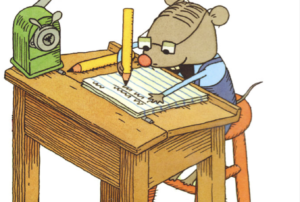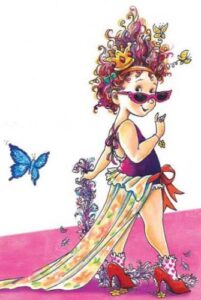
WALLACE'S LIST
Wallace, a mouse, could do almost anything. Anything that is, as long as he had a list.
- Wallace is a shy mouse.
- He writes lists. Lists of recipes, funny words, and frightening experiences.
- Wallace meets his lively neighbor named Albert.
- His world is swiftly opened to new delights, such as painting and music.
- Wallace and Albert experience the excitement of an adventure, and Wallace discovers a new joy.
- Friendship.
From Publishers Weekly
 Three reasons to read coauthors Bottner and Kruglik’s (Pish and Posh) new tale: 1. The two unlikely mouse heroes—the cautious, list-making Wallace and his light-hearted companion Albert—develop a friendship in which Wallace’s shortcomings turn out to be assets. 2. The book might dare readers to discover something new about themselves, too. 3. The plot inspires Landström’s (the Boo and Baa series) tongue-in-cheek artwork, which provides lots of witty entertainment. Wallace, a bespectacled mouse in shorts and a bowtie, wants to say hello to his new neighbor, but he can’t—it’s not on his list of things to do that day. (Readers are treated to many of Wallace’s lists, written neatly on lined paper.) Albert wears an old undershirt, sports long hair and never hesitates to revise his plans: “Changing my mind is an adventure,” he tells Wallace, who listens, appalled but rapt. Eventually Albert’s rash adventure-seeking casts Wallace in the reluctant but gratifying role of hero. He remains steadfast in crises, it turns out, and comforts Albert when his wacky plans go awry. Taking a leaf from classic ’30s cartoons, Landström furnishes interiors with many small but solid-looking items, visual tokens of Wallace’s need for familiarity. His hilarious spreads make liberal use of crosshatching and gestural lines: cats are drenched with water; lightning strikes; luggage carousels send Wallace flying. Bottner and Kruglik don’t insist on a magic transformation from Wallace—he just has to learn to bend a little. This one goes on the recommended list. Ages 4-7. (June)
Three reasons to read coauthors Bottner and Kruglik’s (Pish and Posh) new tale: 1. The two unlikely mouse heroes—the cautious, list-making Wallace and his light-hearted companion Albert—develop a friendship in which Wallace’s shortcomings turn out to be assets. 2. The book might dare readers to discover something new about themselves, too. 3. The plot inspires Landström’s (the Boo and Baa series) tongue-in-cheek artwork, which provides lots of witty entertainment. Wallace, a bespectacled mouse in shorts and a bowtie, wants to say hello to his new neighbor, but he can’t—it’s not on his list of things to do that day. (Readers are treated to many of Wallace’s lists, written neatly on lined paper.) Albert wears an old undershirt, sports long hair and never hesitates to revise his plans: “Changing my mind is an adventure,” he tells Wallace, who listens, appalled but rapt. Eventually Albert’s rash adventure-seeking casts Wallace in the reluctant but gratifying role of hero. He remains steadfast in crises, it turns out, and comforts Albert when his wacky plans go awry. Taking a leaf from classic ’30s cartoons, Landström furnishes interiors with many small but solid-looking items, visual tokens of Wallace’s need for familiarity. His hilarious spreads make liberal use of crosshatching and gestural lines: cats are drenched with water; lightning strikes; luggage carousels send Wallace flying. Bottner and Kruglik don’t insist on a magic transformation from Wallace—he just has to learn to bend a little. This one goes on the recommended list. Ages 4-7. (June)
From School Library Journal
 PreSchool-Grade 2–An earnest and likable mouse is so careful that he lives his life by lists. When a new neighbor introduces himself in the hallway of their apartment building, “Wallace would have liked to say, ‘Hello. My name is Wallace,’ but saying hello was not on his list.” Albert’s spontaneity and joie de vivre slowly win him over. The story culminates in a whirlwind adventure through the airport, into a luxury high-rise, and then back home again, where Wallace makes another list with his new best friend’s name on it. The writing is memorable, and the authors provide just the right details. Larger than life in all sorts of ways, the chubby Albert spouts wise statements such as “Laundry is laundry… but music is life!” Landström’s pictures are expressive and witty, with soft colors, strong lines, and lots of personality. The world depicted is an intriguing one, an urban setting where the mice-sized mice coexist with human-sized humans. With its positive message about trying new experiences and embracing the horizon-expanding wonders of friendship, this picture book is a winner.–Lauralyn Persson, Wilmette Public Library, IL
PreSchool-Grade 2–An earnest and likable mouse is so careful that he lives his life by lists. When a new neighbor introduces himself in the hallway of their apartment building, “Wallace would have liked to say, ‘Hello. My name is Wallace,’ but saying hello was not on his list.” Albert’s spontaneity and joie de vivre slowly win him over. The story culminates in a whirlwind adventure through the airport, into a luxury high-rise, and then back home again, where Wallace makes another list with his new best friend’s name on it. The writing is memorable, and the authors provide just the right details. Larger than life in all sorts of ways, the chubby Albert spouts wise statements such as “Laundry is laundry… but music is life!” Landström’s pictures are expressive and witty, with soft colors, strong lines, and lots of personality. The world depicted is an intriguing one, an urban setting where the mice-sized mice coexist with human-sized humans. With its positive message about trying new experiences and embracing the horizon-expanding wonders of friendship, this picture book is a winner.–Lauralyn Persson, Wilmette Public Library, ILCopyright © Reed Business Information, a division of Reed Elsevier Inc. All rights reserved.
Booklist
 Picture books boast a rich tradition of lovably neurotic characters, from Toad, in Arnold Lobel’s Frog and Toad series, to the anxious lemur in Helen Lester’s Something Might Happen (2003). Joining their risk-averse ranks is a list-loving mouse named Wallace. Every morning Wallace writes down the day’s tasks and then doggedly ticks each one off the list. The drawbacks of this system become obvious when lively, intriguing Albert moves next door: “Wallace would have liked to say, ‘Hello, my name is Wallace,’ but saying hello was not on his list.” As Albert shares his laid-back philosophies (“Wherever I go, there I am”) and demonstrates the joys of spontaneity, it’s not long before Wallace begins to experiment with following his nose. The artwork, by the illustrator of the Baa and Boo books, is charmingly messy with crosshatchings and squiggly fillips, initially providing a humorous contrast to Wallace’s rigidity and then reflecting his increasingly laissez-faire mood. Kids and parents alike will appreciate this gently satirical commentary on our increasingly overprogrammed lives. Jennifer Mattson
Picture books boast a rich tradition of lovably neurotic characters, from Toad, in Arnold Lobel’s Frog and Toad series, to the anxious lemur in Helen Lester’s Something Might Happen (2003). Joining their risk-averse ranks is a list-loving mouse named Wallace. Every morning Wallace writes down the day’s tasks and then doggedly ticks each one off the list. The drawbacks of this system become obvious when lively, intriguing Albert moves next door: “Wallace would have liked to say, ‘Hello, my name is Wallace,’ but saying hello was not on his list.” As Albert shares his laid-back philosophies (“Wherever I go, there I am”) and demonstrates the joys of spontaneity, it’s not long before Wallace begins to experiment with following his nose. The artwork, by the illustrator of the Baa and Boo books, is charmingly messy with crosshatchings and squiggly fillips, initially providing a humorous contrast to Wallace’s rigidity and then reflecting his increasingly laissez-faire mood. Kids and parents alike will appreciate this gently satirical commentary on our increasingly overprogrammed lives. Jennifer Mattson